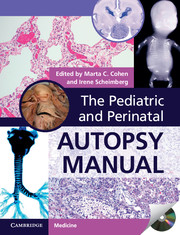Book contents
- Frontmatter
- Contents
- List of contributors
- Foreword
- Preface
- Acknowledgments
- 1 Perinatal autopsy, techniques, and classifications
- 2 Placental examination
- 3 The fetus less than 15 weeks gestation
- 4 Stillbirth and intrauterine growth restriction
- 5 Hydrops fetalis
- 6 Pathology of twinning and higher multiple pregnancy
- 7 Is this a syndrome? Patterns in genetic conditions
- 8 The metabolic disease autopsy
- 9 The abnormal heart
- 10 Central nervous system
- 11 Significant congenital abnormalities of the respiratory, digestive, and renal systems
- 12 Skeletal dysplasias
- 13 Congenital tumors
- 14 Complications of prematurity
- 15 Intrapartum and neonatal death
- 16 Sudden unexpected death in infancy
- 17 Infections and malnutrition
- 18 Role of MRI and radiology in post mortems
- 19 The forensic post mortem
- 20 Appendix tables
- Index
- References
18 - Role of MRI and radiology in post mortems
Published online by Cambridge University Press: 05 September 2014
- Frontmatter
- Contents
- List of contributors
- Foreword
- Preface
- Acknowledgments
- 1 Perinatal autopsy, techniques, and classifications
- 2 Placental examination
- 3 The fetus less than 15 weeks gestation
- 4 Stillbirth and intrauterine growth restriction
- 5 Hydrops fetalis
- 6 Pathology of twinning and higher multiple pregnancy
- 7 Is this a syndrome? Patterns in genetic conditions
- 8 The metabolic disease autopsy
- 9 The abnormal heart
- 10 Central nervous system
- 11 Significant congenital abnormalities of the respiratory, digestive, and renal systems
- 12 Skeletal dysplasias
- 13 Congenital tumors
- 14 Complications of prematurity
- 15 Intrapartum and neonatal death
- 16 Sudden unexpected death in infancy
- 17 Infections and malnutrition
- 18 Role of MRI and radiology in post mortems
- 19 The forensic post mortem
- 20 Appendix tables
- Index
- References
Summary
Introduction
Imaging assists the pathologist to visualize abnormalities that may not be evident to direct inspection. Post mortem imaging should be performed on all children where there is any suspicion about the cause of death (coronial or medical examiner request); in neonatal death; intrauterine fetal death; and termination of pregnancy for fetal abnormalities. Forensic autopsies may be performed with parental consent or as directed by the coroner (or equivalent legal officer).
The most common imaging modality is plain radiography. This can be performed either in the autopsy suite or using more specialized techniques. Most pediatric pathology departments have a dedicated imaging device, which uses low kilo-voltage (kV) X-rays to achieve maximum contrast and special imaging plates to achieve good spatial resolution and contrast on small specimens. For the larger fetus and in infants or children, plain radiography is performed by moving the body to the imaging department or alternatively using a portable machine in the autopsy room.
Imaging can assist the pathologist in diagnosis and guiding selective resection of bones followed by specimen radiography and then histopathological assessment.
More recently post mortem ultrasound (US), computed tomography (CT), or magnetic resonance (MR) scanning may allow further assessment and selective biopsy or restricted autopsy [1]. This is particularly useful in children whose parents have reservations about full autopsy. In the future “virtual autopsy” may be feasible. However, currently there are few detailed studies and experience in the clinical setting is limited.
- Type
- Chapter
- Information
- The Pediatric and Perinatal Autopsy Manual , pp. 362 - 375Publisher: Cambridge University PressPrint publication year: 2000



